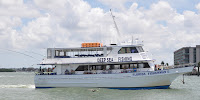King Mackerel Fast Facts
 Kingfish or Kings are a part of the Scombridae family which
includes more than 30 different species of fish (such as tuna and bonito).
Kings grow fast, they can grow 19in to 35in in length, the biggest recorded kingfish
is 72in and weighed 99lbs (now that’s a lot of fishspread). Much like other members of this genus, they
are carnivorous, typically preferring small fish such as grunts, porgy and
snapper, but they will also eat crustaceans, mollusks, shrimp and squid.
Kingfish or Kings are a part of the Scombridae family which
includes more than 30 different species of fish (such as tuna and bonito).
Kings grow fast, they can grow 19in to 35in in length, the biggest recorded kingfish
is 72in and weighed 99lbs (now that’s a lot of fishspread). Much like other members of this genus, they
are carnivorous, typically preferring small fish such as grunts, porgy and
snapper, but they will also eat crustaceans, mollusks, shrimp and squid.- King mackerel are iron-gray on the back and silvery on their sides and belly.
- They have pale to dusky fins.
- Small king mackerel sometimes have spots like the Spanish mackerel, but king mackerel can be distinguished by their sharply dipping lateral line and gray anterior (near the front) dorsal (the upper side) fin.
- King mackerel grow fast, up to 5 ½ feet and 100 pounds.
- · They can live more than 20 years.
- · They start to reproduce when they reach 2 years of age.
- · There are two distinct populations, one in the Gulf of Mexico and one in the Atlantic.
- They spawn on the outer continental shelf from May through October. Females release eggs in the open water, where they are fertilized.
- · Females grow much larger than males, an evolutionary strategy that maximizes the amount of eggs that a female can produce. Females can produce 50,000 to several million eggs.
- · King mackerel are carnivores, feeding on fish, squid, and shrimp. They’re voracious feeders and have been observed leaping out of the water in pursuit of prey.
- · Juvenile and larger pelagic fish feed on smaller king mackerel. Bottlenose dolphins and large fish, such as sharks and tunas, feed on adult king mackerel.
We offer 5, 10, 12, 39, 44, & 63 hour party boat fishing trips. We also offer private charters for corporate events, bachelor parties, family trips, cruises and more. We have daily dolphin watching nature cruise & Eco tours, and a daily (in season) sunset cruise with free beer and wine.
Hubbard’s also has a Egmont Key ferry with a snorkeling option that runs daily from Fort de Soto park’s Bay pier out to Egmont key (an island only accessible by boat). We also offer a 3 hour beach shelling cruise that leaves from Hubbard’s marina. We also provide Kayak and paddleboard rentals.





Comments
Post a Comment